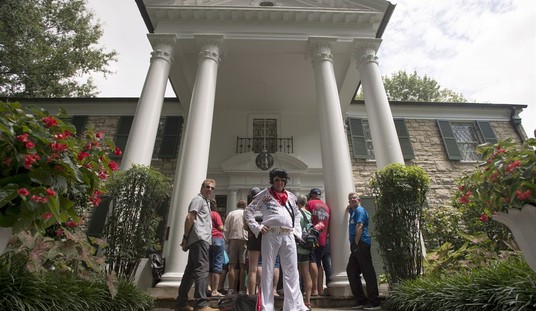Just how will the US economy rebound once all of the COVID-19 restrictions get removed? That depends in large part how quickly those restrictions get rolled back, and whether or not those rollbacks generate a “second wave” that requires another round of curve-flattening shutdowns. The Wall Street Journal takes a pessimistic view of the potential for a V-shaped recovery, especially in the manufacturing sector. The problem of unemployment will create a vicious cycle of declining demand, the very phenomenon that Congress hoped to avoid.
In fact, we’re already seeing this as temporary shutdowns have started to become permanent decisions:
Factory furloughs across the U.S. are becoming permanent closings, a sign of the heavy damage the coronavirus pandemic and shutdowns are exerting on the industrial economy.
Makers of dishware in North Carolina, furniture foam in Oregon and cutting boards in Michigan are among the companies closing factories in recent weeks. Caterpillar Inc. said it is considering closing plants in Germany, boat-and-motorcycle-maker Polaris Inc. plans to close a plant in Syracuse, Ind., and tire maker Goodyear Tire & Rubber Co. plans to close a plant in Gadsden, Ala.
Those factory shutdowns will further erode an industrial workforce that has been shrinking as a share of the overall U.S. economy for decades. While manufacturing output last year surpassed a previous peak from 2007, factory employment never returned to levels reached before the financial crisis.
Consumer spending has been the engine of the American economy, which has allowed for incredible resilience in times of economic stress. The mass layoffs of the COVID-19 shutdowns has made that engine seriously misfire, says University of Michigan researcher Gabriel Ehrlich. That has sidelined so many consumers that demand can’t possibly rebound properly, even with stimulus checks in hand:
The more that job losses turn from temporary to permanent, he said, the harder the hit to consumer spending and every company that relies on it—including manufacturers.
“The higher the proportion of permanent layoffs, the worse the chances of a strong recovery start to look,” Mr. Ehrlich said.
One interesting aspect of this is its focus on manufacturing. This kind of concern might be more focused on the service sector, which relies in large part on in-person economic activity. Some of that can be done remotely, such as financial services, banking, even some retail business. Hair and nail salons, coffee shops, clothing stores and the like that feature higher-density customer experiences and surface sharing will find it much tougher to protect against transmission — more so than most manufacturing plants. However, the issue is the same for both sectors, which is that products and services will suffer from lower demand from a consumer base with much less excess cash — and likely a desire to stay out of the stores for a long while, if possible.
With that in mind, the push to reopen American economic activity is gaining strength, hoping to rescue most of these lost jobs before they permanently evaporate. Protests over the shutdown orders are still opposed by the majority of Americans, according to a new AP/NORC poll, but those numbers are declining:
A majority of Americans disapprove of protests against restrictions aimed at preventing the spread the coronavirus, according to a new poll that also finds the still-expansive support for such limits — including restaurant closures and stay-at-home orders — has dipped in recent weeks.
The new survey from the University of Chicago Divinity School and The Associated Press-NORC Center for Public Affairs Research finds 55% of Americans disapprove of the protests that have popped up in some states as some Americans begin chafing at public health measures that have decimated the global economy. Thirty-one percent approve of the demonstrations. …
Democrats are more likely than Republicans to disapprove of such protests, 67% to 51%. Thirty-two percent of Republicans and 25% of Democrats say they approve. Only 8% said public protests, marches and rallies should be unrestricted during the outbreak, while 41% think they should be allowed only with restrictions and 50% think they should not be allowed at all.
At The Atlantic, Conor Friedersdorf argues that the protesters should be respected — because they have a point:
If we knew that a broadly effective COVID-19 treatment was imminent, or that a working vaccine was months away, minimizing infections through social distancing until that moment would be the right course. At the other extreme, if we will never have an effective treatment or vaccine and most everyone will get infected eventually, then the costs of social distancing are untenable. We don’t know where we sit on that spectrum. So we cannot know what the best way forward is even if we place the highest possible value on preserving life and protecting the vulnerable.
That uncertainty means, at the very least, that Americans should carefully consider the potential costs of prolonged shutdowns lest they cause more deaths or harm to the vulnerable than they spare.
Ongoing closures and supply-chain interruptions in wealthier countries could have catastrophic ripple effects, Michael T. Klare warns in The Nation, highlighting the possibility that global starvation could soar. “Even where supply chains remain intact, many poor countries lack the funds to pay for imported food,” he explained. “This has long been a problem for the least-developed countries, which often depend on international food aid … It is becoming even more severe as the number of people without jobs multiplies and donor countries balk at higher aid expenditures.” His article wasn’t a brief for reopening the economy, but it implied a need to guard against shutdowns that cause more deaths via starvation than are saved by slowing infections.
“A prolonged depression will stunt lives as surely as any viral epidemic, and its toll will not be confined to the elderly,” Heather Mac Donald argues at Spectator USA. “The shuttering of auto manufacturing plants led to an 85 percent increase in opioid overdose deaths in the surrounding counties over seven years, according to a recent study.” Deficit spending may be necessary to keep people afloat, she continued, but the wealth that permits it could quickly evaporate. “The enormously complex web of trade, once killed, cannot be brought back to life by government stimulus. And who is going to pay for all that deficit spending as businesses close and tax revenues disappear?”
Lest anyone think a second Great Depression is out of the question, hedge-fund exec Paul Tudor Jones tells CNBC’s Squawk Box that the clock is indeed ticking. It’s this fear that has more and more people questioning just how long “flatten the curve” is supposed to go, and which curves we’re actually flattening at this point.







